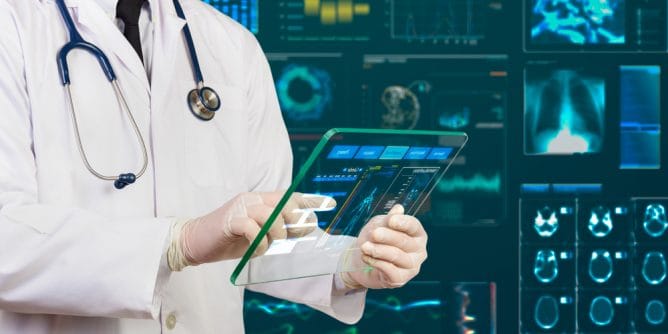Technology and medicine have been going hand in hand for years. New technologies in medicine, in drugs and in medical equipment have completely changed the face of the medical field and pharmaceuticals. Telemedicine, robotic technology, technologies are using big data and artificial intelligence, mobile health and augmented reality. Medicine is far ahead of many other fields in embracing technology. And the changes that these technologies bring are noticeable to many, as they enable earlier detection of diseases, prevent their development, give more people access to medicine, and ultimately – improve people’s quality of life. As we have stated before, modern world is full of new useful gadgets and tools for healthcare as well.
Information Technologies in Medicine
E-medicine is a new way to treat, a new industry of health care, which is based on the power of information technology and develops an intelligent holistic environment, capable of managing the delivery of medical care to the population everywhere, helping doctors, nursing staff in bringing into clinical practice the latest methods of diagnosis, treatment and the ability to work together between doctors in different geographical locations
Digitization was and still is the most popular technology. Paper charts, cardiograms, and scans have all gone digital.
The resulting information had to be structured in such a way that it could be handled by anyone who needed it. Databases and tools to manage these databases appeared – an interface linking the user and his or her functions with the database.
The accumulation of large amounts of data and the ability to isolate and verify the relationships between them – for example, between the nature of the disease and the prescription – made it possible to apply decision support systems in medicine. The same conditions determine the possibility of developing expert systems, artificial intelligence and machine learning.
The Development of Telemedicine
Today, telemedicine allows physicians to continuously monitor patients’ medical parameters, broadcast surgical procedures, undergo tele-training and conduct online consultations. The advantages of telemedicine are considered to be the possibility of reducing costs and solving the problem of inequality of access to medical care – when people from small settlements have less opportunity to see a qualified doctor than residents of big cities. All this can fundamentally transform the existing healthcare system by improving quality and patient satisfaction.
Patients, caregivers and organizations are increasingly using technology to better understand health-related processes as well, from tools that report blood glucose levels to wearable devices like smartwatches that can detect the wearer’s fall and report it to emergency services. All of these systems involve the accumulation of huge amounts of information. Subsequently, big data in the medical field helps experts see patterns in patient morbidity.
IT in Medicine
What issues does IT in medicine solve? It seems that the main goal of information technology is to free doctors from the pile of paperwork and devote the time saved to patients. In part, yes, but that’s just the tip of the iceberg. The more IT has been integrated into the medical process, the wider its application in the medical sector has become.
It is important to mention how advanced various scientific research has become with the development of computer technology. The construction of complex mathematical models makes it possible to predict the development of epidemics and, consequently, to focus on preventive measures. The use of IT in the study of the human genome has made it possible to develop special genetic tests that can show a person’s predisposition to various oncological and neurodegenerative diseases.
Innovative medical technologies are becoming more and more impressive. They continue to improve, providing mankind with fantastic prospects. And more importantly, they are becoming more and more accessible to more people.
